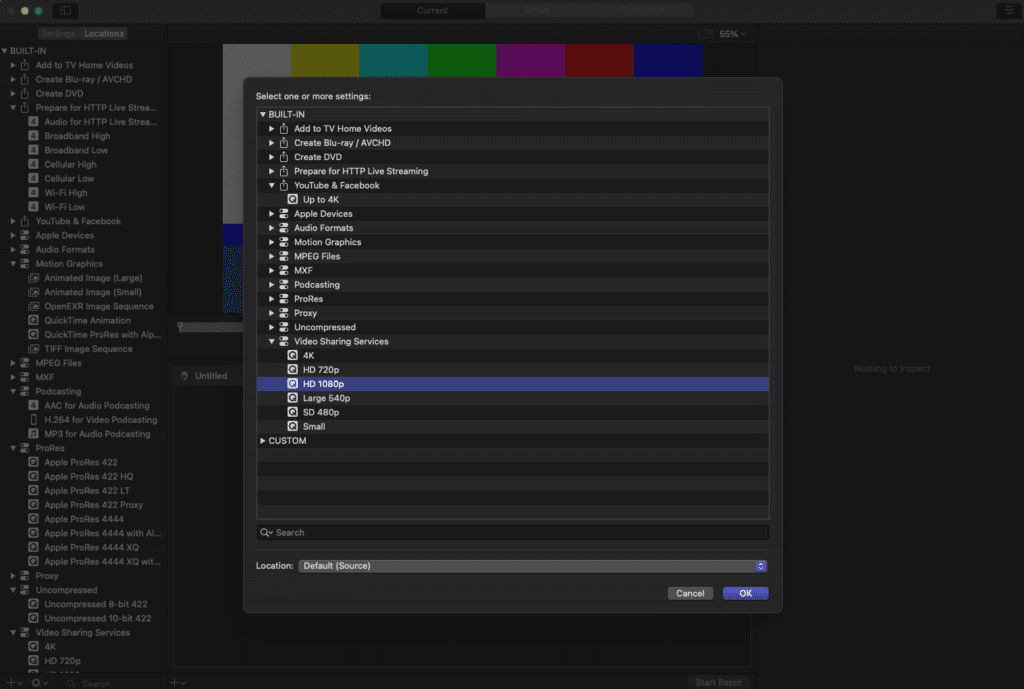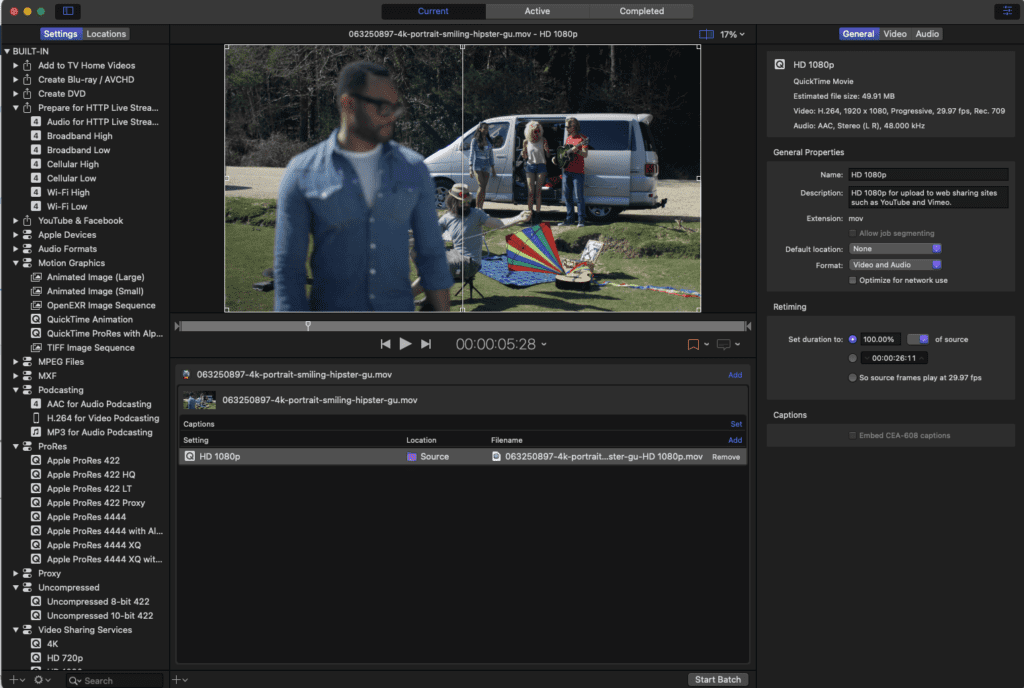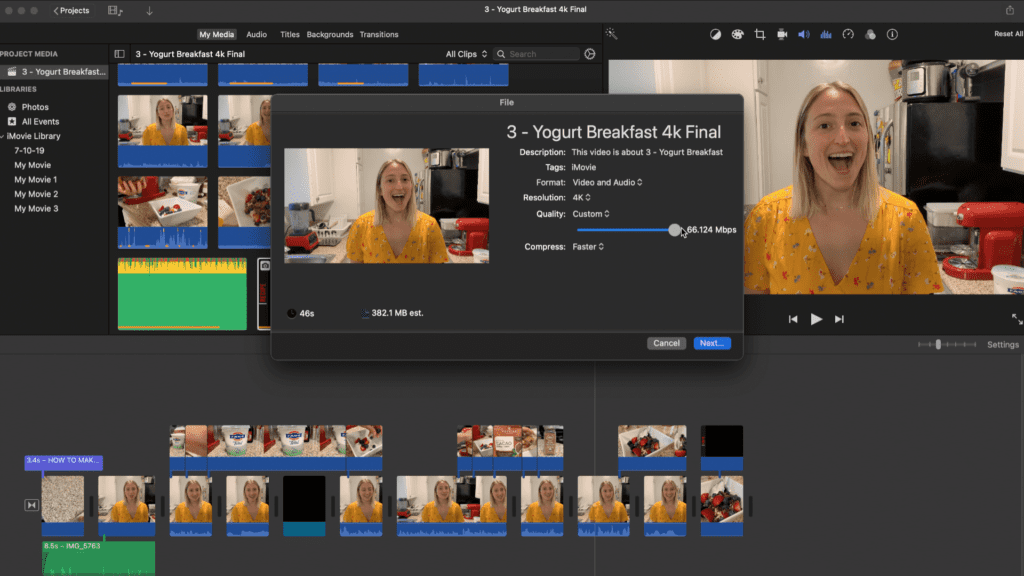What Kind Of Videos Can You Upload To Youtube
You've spent many hours, and perhaps thousands of dollars on high-quality cameras and computers, shooting and editing your latest YouTube video. The last affair y'all want is for all that work to go to waste because your project exported also compressed and pixelated.
Don't worry; we've got you covered. Whether y'all're uploading a video for your business, vlog, or passion, in this guide, we'll cover everything you need to know about exporting and uploading videos to YouTube, including:
- The best settings to export to YouTube
- What files and specs YouTube accepts
- Mutual questions about uploading different files to YouTube
What types of files can you lot upload to YouTube?
The following are file formats supported for upload to YouTube:
- .MOV
- .MPEG4
- .MP4
- .AVI
- .WMV
- .MPEGPS
- .FLV
- 3GPP
- WebM
- DNxHR
- ProRes
- CineForm
- HEVC (h265)
MOV, MP4, and AVI are the most common types of files you'll use.
Your video editing software should be able to export to ane of the higher up YouTube video upload formats. If you have an existing file that y'all're trying to convert, diverse encoding apps can too help yous convert audio and video files. We have some suggestions below.
What is the difference between video file containers and video codecs?
A video codec is the method used to compress and decompress the video. Raw video and audio take a lot of storage space; therefore, video codec compresses the information making information technology easier to shop it. The most common types of codec used these days are H.264 and MPEG.
The video file container stores the video file and related media. Afterwards the codec compresses the file, you can store it in a video file container. Some pop types of video file containers include MOV, MP4, AVI, VOB, and MKV.

YouTube Recommended Encoding Specifications
For optimum performance, YouTube recommends specific encoding settings for exporting and uploading your media. These YouTube video upload specs offering information regarding the recommended video container, video codec, audio codec, frame rate, bitrate, resolution & aspect ratio, and color infinite.
While other upload specifications and settings volition as well work, reduced settings may produce a lower quality video, such every bit pixelation and washed-out colors.
Recommended Settings for Standard Dynamic Range (SDR) Videos
| Container | MP4 |
| Video Codec | H264 |
| Audio Lawmaking | AAC-LC in Stereo or 5.one surround, with a sample rate of 96khz or 48khz |
| Frame Rate | Aforementioned frame rate as recorded, usually 24, 25, 30, or 60 FPS |
| Bitrate | 4K Videos: 35-45 Mbps 1080 Hard disk drive Videos: viii Mbps |
| Resolution | 4K: 3840 x 2160 HD: 1920 x 1080 Export at the setting about of your video was shot in |
| Aspect Ratio | 16:ix (YouTube will automatically letterbox anything not uploading in this ratio) |
| Color Space | BT or Rec 709 |
Recommended Settings for High Dynamic Range (HDR) Videos
YouTube currently supports HDR videos. HDR is a special format that accommodates a wider set of color data, producing more vibrant images. But it's but available when shooting with supported cameras and edited in software that supports HDR. If you lot're not sure if your video is HDR, it most likely is SDR (Standard Dynamic Range).
| Container | MOV MP4 MKV |
| Video Codec | H.264 10 bitVP9 Contour 2ProRes 422ProRes 4444DNxHR HQX |
| Audio Code | AAC-LC in Stereo or 5.1 surround, with a sample rate of 96khz or 48khz |
| Frame Rate | Same frame rate as recorded, usually 24, 25, xxx, or 60 FPS |
| Bitrate | 4K Videos: 44-56 Mbps 1080 Hard disk Videos: 10 Mbps |
| Resolution | 4K: 3840 x 2160 Hard disk drive: 1920 10 1080 Consign at the setting almost of your video was shot in |
| Aspect Ratio | 16:9 (YouTube volition automatically letterbox anything non uploading in this ratio) |
| Color Space | BT or Rec 709 |
Read this for more on HDR requirements on YouTube.
Best Quality Consign Settings for YouTube Video

While the higher up is YouTube's recommended settings, if your software and internet speed support information technology, there are a few means to go even college quality video uploaded to YouTube.
YouTube's max file size limit is 128 GB – large enough to handle professional-grade codecs. So if you lot have the speed to back up it, here are our recommended max settings.
But keep in heed, your terminal output is only equally good as your source video. Exporting at a higher setting than the video you shot won't magically make your video college quality.
Best Settings for 1080p HD Videos
File: MOV
Format: ProRes 422
Dimensions: 1920 x 1080p
Frame Rate: Same as recorded
Bitrate: 12 Mbps+ You may also employ ii-pass variable bitrate, VBR two-laissez passer, where available.
Sound file format: AAC
All-time Settings for 4K Videos
With some exceptions, you can employ a similar setting for 4K videos. Here is a general guideline to get the best quality:
File: MOV
Format: ProRes 422
Dimensions: 3840p x 2160p
Frame Charge per unit: Aforementioned as recorded
Bitrate: 45 Mbps+
Sound File format: AAC
All-time Video Format to Upload to YouTube
YouTube recommends uploading videos in MP4 using the H.264 video codec and AAC audio codec.
If your computer and editing software supports information technology, ProRes 422 is the highest quality file format to upload to YouTube.
Well-nigh cameras still shoot in Hd resolution at 1920×1080 pixels. If your video was shot at this size, then you desire to upload it in that size.
If you're using a smartphone, the YouTube app on iOS and Android lets you catechumen your videos to 1080p.
Newer cameras and smartphones now record in 4K or 2160p. If you have the storage space, this is the best choice to shoot and upload your video as it'southward much higher quality and helps futurity-proof your video resolution.
If you're in the US, you'll want to employ a frame charge per unit of 24 or 30 fps. 25 fps is common in Europe and Asia.
Gaming videos and some vlogs tend to tape at threescore fps. This creates a smoother, more than hyper-realistic prototype. 24 fps is the traditional charge per unit for cinema.
There'due south no correct frame rate – it'south actually a style choice.
You should shoot and consign your video with a xvi:9 ratio (horizontal format). If your video was shot vertically, YouTube will automatically add black confined on either side and shrink information technology to fit inside a 16:9 box. It doesn't look cracking, so y'all should really shoot in 16:9.
Consign your video to MP4. YouTube recommends using H.264 codec for encoding. Other popular codecs are MPEG-four and MPEG-ii.
How to Encode a Video for YouTube

The all-time mode to encode a video for YouTube is by exporting it from your editing program.
Nigh video editing software supports the H.264 video codec recommended by YouTube. Using H.264 video codec to encode a video is also practical because mod camcorders, smartphones, and recording equipment record in H.264 format.
Exporting your video from iMovie volition do this automatically.
Some video editing programs do non back up H.264 and MPEG-2. In such cases, you can use additional encoding software.
Here is a listing of five popular apps that you can use to encode a video for YouTube:
Adobe Media Encoder
Apple tree Compressor
FFmpeg (costless)
Handbrake (free)
Commonly Asked Questions about Exporting and Uploading to YouTube
What format does YouTube upload the fastest?
YouTube recommends uploading your videos in mp4 format for faster uploads using the H.264 video codec and AAC-LC audio codec. The upload time volition also depend on the duration and the size of your video. The maximum file size is 128GB.
How can I lower YouTube file size without losing quality?
Y'all can reduce large-sized videos to a much smaller size without losing quality by using a video compressor. The large size of the video is more often than not due to resolution, bitrate, and encoding. Try using different bitrate settings until you find ane that produces a small-scale enough file size while still looking good.
Can you lot upload QuickTime to YouTube?
YouTube supports uploading QuickTime videos in MOV format. For smaller files with practiced quality, use the H.264 video codec. For the highest quality possible, use ProRes 422.
Can yous upload MPEG to YouTube?
Aye, YouTube supports MPEG format. For best results, utilize MPEG-4 or MPEG-2 formats.
Tin can you upload MP4 to YouTube?
YouTube recommends MP4s as the best file type to upload to YouTube. When uploading an mp4 video, use H.264 video codec and AAC-LC audio codec for optimal results.
Can you upload MOV to YouTube?
MOV is 1 of the many video formats for YouTube. If your MOV file is large, use a video compressor to adjust the size earlier uploading.
Tin you upload AVI to YouTube?
YouTube supports AVI format. This is an extremely mutual video format for YouTube when working on Windows computers.
Tin can you upload WMV to YouTube?
The WMV is among the supported formats on YouTube. If you're facing issues uploading the content, it's likely because YouTube does non recognize certain audio and video streams of WMV files. In such cases, convert the file to FLV, AVI, or another format before proceeding with the upload.
Can you upload FLV to YouTube?
Yep, you can use FLV to upload the video to YouTube. If you lot get an "invalid file format" fault, information technology may be because the video is not encoded with Adobe-FLV1 video codec, MP3, and AAC audio. Use the advisable video and audio codec settings for easier uploads.
Can you lot upload WebM to YouTube?
Yous tin can upload a video on YouTube using WebM format. Compared to MP4, it has a relatively smaller file size and offers similar compression. All the major Internet browsers as well support WebM.
We hope you found this guide useful. If you're looking to live stream with YouTube Live, brand sure to cheque out our virtual consequence guide.
Source: https://newterritory.media/youtube-upload-formats/
Posted by: crowderdinduch.blogspot.com

0 Response to "What Kind Of Videos Can You Upload To Youtube"
Post a Comment